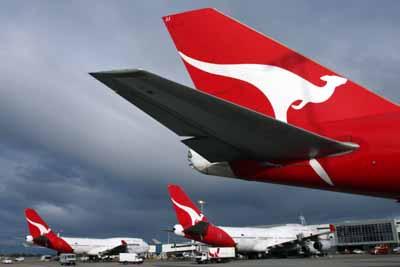Qantas Plans Workforce Cuts, Lengthy Widebody Groundings

Qantas Airways has unveiled a three-year strategy to prepare for a slow airline industry recovery, including cutting 6,000 workers, storing or retiring larger widebody airliners, and raising A$1.9 billion ($1.3 billion) in new equity to fund its plans.
Substantial job losses were widely expected as Qantas developed its blueprint to recover from the COVID-19 crisis. The 6,000 cuts—nearly 20% of its 29,000 workers—reflect the fact that the airline expects to be smaller than its pre-coronavirus size for the foreseeable future.
In addition to the permanent cuts, Qantas said an additional 15,000 of its workers will remain on stand-down until more of its services resume. The carrier estimates it will have 8,000 employees working by the end of July, growing to 15,000 by year-end and 21,000 by June 2022.
Employees on stand-down can use annual leave or receive funding under the Australian government’s JobKeeper wage-subsidy program. This program is due to expire in September, but Qantas CEO Alan Joyce said the government is considering extending the wage subsidies for airline and tourism workers.
The redundancies will be mainly in the group’s international operation, which is expected to recover much more slowly than the domestic business. The carrier has begun union consultations and aims to seek voluntary redundancies before turning to involuntary cuts.
Job losses will affect Qantas and its Jetstar subsidiary. The company is estimating the total will include about 1,450 non-operational and headquarters workers; 1,500 ground operations jobs; 1,050 cabin crewmembers; 630 from the engineering division; and 220 pilots.
The crew and engineering cuts partly reflect the airline’s decision to retire its six remaining Boeing 747-400s about six months earlier than planned. Some jobs also will be lost as low-cost subsidiary Jetstar shifts aircraft maintenance from its Newcastle facility to another in Melbourne.
About 100 of the group’s aircraft will remain grounded for at least a year, including most of the international fleet. The airline’s 12 Airbus A380s will be stored for at least three years. Qantas intends to return the A380s to service eventually, but for now they are too big to match anticipated international demand, Joyce said.
Qantas already has canceled all international flights until late October, with the potential exception of routes to and from New Zealand. The CEO noted it might take a year for international services to resume in any meaningful way.
“There’ll be nothing this next financial year; July next year we may start seeing some international services and that will only get us to 50%,” Joyce predicted. “The following year, only two-thirds of the pre-COVID international schedule [will operate].”
The exceptions will be the likely restart of flights to New Zealand this year and possibly some other similar bilateral “travel bubble” arrangements with other countries.
As reported by Aviation Daily sister publication Routes, Qantas intended to operate 48 nonstop international routes during the IATA 2020 summer season, 11 of which would have connected destinations in Australia and New Zealand. In total, the carrier planned to offer about 200,000 weekly international seats during the season.
When international services do resume, the group will use its 787s and A330s to operate flights to North America, Asia and London as required, Joyce said. Qantas already has signaled it will be deferring 787-9 and A321neo deliveries due this year. The A321neos were on order for Jetstar.
The CEO said he still intends to order A350-1000s at some point for the carrier’s proposed ultra-long-haul flights known as Project Sunrise. While the confirmation of this order has been postponed due to COVID-19, Joyce said these flights remain in the carrier’s long-term plan.
“Despite the hard choices we’re making today, we’re fundamentally optimistic about the future,” Joyce said. “Almost two-thirds of our pre-crisis earnings came from the domestic market, which is likely to recover fastest—particularly as state borders prepare to open.” Joyce added the group plans to restore 40% of its pre-crisis domestic flying during July and “hopefully more in the months that follow.”
The A$1.9 billion in new equity will comprise A$1.4 billion in a fully underwritten share placement with institutional investors and an A$500 million share-purchase plan for existing stockholders. This will result in a 25% increase in total issued shares.
The funds raised will be used to “accelerate the group’s recovery, strengthen its balance sheet and position it to capitalize on opportunities aligned with its strategy,” the airline said.
In parallel with Qantas’ developments, its Singapore-based LCC subsidiary Jetstar Asia has announced that it will remove five A320s from its fleet and lay off around a quarter its workforce, or 180 personnel.
A Jetstar Asia spokesperson confirmed that one A320 will be returned to Vietnam-based Jetstar Pacific and the remaining four to Qantas. That will leave Jetstar Asia with 13 A320s, all leased.
On top of letting go 180 personnel, Jetstar Asia is also extending the furlough period for the majority of its workforce until the end of the year.
“There is no doubt that the travel market will look very different moving forward, so it is imperative that we change and adapt,” Jetstar Asia CEO Bara Pasupathi said. “Today’s decisions, while extremely difficult, ensure Jetstar Asia will be ready to recover when international travel demand resumes and allows us to remain agile while staying true to our low-cost DNA.”
Jetstar Asia suspended operations from March 23 and resumed a limited schedule from April 21, flying a single weekly flight to Manila, Philippines, and 2X-weekly flights to Bangkok and Kuala Lumpur to repatriate citizens.







